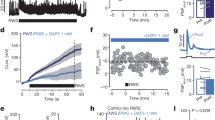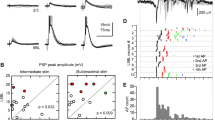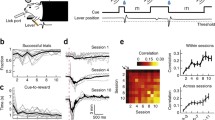Abstract
Integrative properties of single neurons have been extensively studied in acute brain slices. However, these preparations are characterized by extremely low levels of synaptic and action potential activity. In comparison to in vivo, reduced intracortical input and lack of subcortical modulation increase the effective difference between mean membrane potential and spiking threshold, preventing self-sustained network activity in vitro. To elicit an increased and stable network activity (INA) in vitro comparable to that found in awake animals, we mimicked subcortical cholinergic and serotoninergic inputs using carbachol or barium alone or in combination with serotonin in layer 5 pyramidal cells in slices of mouse somatosensory cortex. INA is primarily induced by a modulation of intrinsic conductances resulting in a depolarization of the membrane potential. We studied the impact of INA on synaptic and somatodendritic integration using extracellular stimulation and dendritic calcium imaging. Synaptic inhibition is strengthened due to an increased driving force for chloride. The critical frequency at which somatic action potentials induce a dendritic calcium action potential is lowered. Simultaneous inhibitory synaptic input is powerful enough to suppress dendritic calcium action potential generation. Pharmacologically induced INA enables the study of neuronal integration in well-accessible cortical slices within an active network.









Similar content being viewed by others
References
Abeles M (1982) Local cortical circuits—an electrophysiological study. Springer, Berlin Heidelberg New York
Agmon A, Connors BW (1991) Thalamocortical responses of mouse somatosensory (barrel) cortex in vitro. Neuroscience 41:365–379
Aracri P, Colombo E, Mantegazza M, Scalmani P, Curia G, Avanzini G, Franceschetti S (2006) Layer-specific properties of the persistent sodium current in sensorimotor cortex. J Neurophysiol 95:3460–3468
Baranyi A, Szente MB, Woody CD (1993) Electrophysiological characterization of different types of neurons recorded in vivo in the motor cortex of the cat. II. Membrane parameters, action potentials, current-induced voltage responses and electrotonic structures. J Neurophysiol 69:1865–1879
Berger T, Larkum ME, Lüscher HR (2001) High Ih channel density in the distal apical dendrite of layer V pyramidal cells increases bidirectional attenuation of EPSPs. J Neurophysiol 85:855–868
Berger T, Lüscher HR, Giugliano M (2006) Transient rhythmic network activity in the somatosensory cortex evoked by distributed input in vitro. Neuroscience 140:1401–1413
Berger T, Senn W, Lüscher HR (2003) Hyperpolarization-activated current Ih disconnects somatic and dendritic spike initiation zones in layer V pyramidal neurons. J Neurophysiol 90:2428–2437
Buhl EH, Tamas G, Fisahn A (1998) Cholinergic activation and tonic excitation induce persistent gamma oscillations in mouse somatosensory cortex in vitro. J Physiol 513:117–126
Capogna M, Gähwiler BH, Thompson SM (1996) Calcium-independent actions of alpha-latrotoxin on spontaneous and evoked synaptic transmission in the hippocampus. J Neurophysiol 76:3149–3158
Chen D, Fetz EE (2005) Characteristic membrane potential trajectories in primate sensorimotor cortex neurons recorded in vivo. J Neurophysiol 94:2713–2725
Crochet S, Petersen CC (2006) Correlating whisker behavior with membrane potential in barrel cortex of awake mice. Nat Neurosci 9:608–610
Descarries L, Gisiger V, Steriade M (1997) Diffuse transmission by acetylcholine in the CNS. Prog Neurobiol 53:603–625
Destexhe A, Pare D (1999) Impact of network activity on the integrative properties of neocortical pyramidal neurons in vivo. J Neurophysiol 81:1531–1547
Destexhe A, Rudolph M, Pare D (2003) The high-conductance state of neocortical neurons in vivo. Nat Rev Neurosci 4:739–751
DeWeese MR, Zador AM (2006) Non-Gaussian membrane potential dynamics imply sparse, synchronous activity in auditory cortex. J Neurosci 26:12206–12218
Grasso A, Alema S, Rufini S, Senni MI (1980) Black widow spider toxin-induced calcium fluxes and transmitter release in a neurosecretory cell line. Nature 283:774–776
Gulledge AT, Stuart GJ (2005) Cholinergic inhibition of neocortical pyramidal neurons. J Neurosci 25:10308–10320
Harvey PJ, Li X, Li Y, Bennett DJ (2006) 5-HT2 receptor activation facilitates a persistent sodium current and repetitive firing in spinal motoneurons of rats with and without chronic spinal cord injury. J Neurophysiol 96:1158–1170
Helmchen F, Svoboda K, Denk W, Tank DW (1999) In vivo dendritic calcium dynamics in deep-layer cortical pyramidal neurons. Nat Neurosci 2:989–996
Henkel AW, Sankaranarayanan S (1999) Mechanisms of alpha-latrotoxin action. Cell Tissue Res 296:229–233
Henze DA, McMahon DB, Harris KM, Barrionuevo G (2002) Giant miniature EPSCs at the hippocampal mossy fiber to CA3 pyramidal cell synapse are monoquantal. J Neurophysiol 87:15–29
Hill JJ, Peralta EG (2001) Inhibition of a Gi-activated potassium channel (GIRK1/4) by the Gq-coupled m1 muscarinic acetylcholine receptor. J Biol Chem 276:5505–5510
Krnjevic K, Pumain R, Renaud L (1971a) Effects of Ba2+ and tetraethylammonium on cortical neurones. J Physiol 215:223–245
Krnjevic K, Pumain R, Renaud L (1971b) The mechanism of excitation by acetylcholine in the cerebral cortex. J Physiol 215:247–268
Larkum ME, Kaiser KM, Sakmann B (1999a) Calcium electrogenesis in distal apical dendrites of layer 5 pyramidal cells at a critical frequency of back-propagating action potentials. Proc Natl Acad Sci USA 96:14600–14604
Larkum ME, Zhu JJ (2002) Signaling of layer 1 and whisker-evoked Ca2+ and Na+ action potentials in distal and terminal dendrites of rat neocortical pyramidal neurons in vitro and in vivo. J Neurosci 22:6991–7005
Larkum ME, Zhu JJ, Sakmann B (1999b) A new cellular mechanism for coupling inputs arriving at different cortical layers. Nature 398:338–341
Lazarovici P, Lelkes PI (1992) Pardaxin induces exocytosis in bovine adrenal medullary chromaffin cells independent of calcium. J Pharmacol Exp Ther 263:1317–1326
Lee AK, Manns ID, Sakmann B, Brecht M (2006) Whole-cell recordings in freely moving rats. Neuron 51:399–407
London M, Häusser M (2005) Dendritic computation. Annu Rev Neurosci 28:503–532
Lucas-Meunier E, Fossier P, Baux G, Amar M (2003) Cholinergic modulation of the cortical neuronal network. Pflugers Arch 446:17–29
Maclean JN, Watson BO, Aaron GB, Yuste R (2005) Internal dynamics determine the cortical response to thalamic stimulation. Neuron 48:811–823
Margrie TW, Brecht M, Sakmann B (2002) In vivo, low-resistance, whole-cell recordings from neurons in the anaesthetized and awake mammalian brain. Pflugers Arch 444:491–498
Matsumura M, Cope T, Fetz EE (1988) Sustained excitatory synaptic input to motor cortex neurons in awake animals revealed by intracellular recording of membrane potentials. Exp Brain Res 70:463–469
McCormick DA (1989) Cholinergic and noradrenergic modulation of thalamocortical processing. Trends Neurosci 12:215–221
McCormick DA, Prince DA (1986) Mechanisms of action of acetylcholine in the guinea-pig cerebral cortex in vitro. J Physiol 375:169–194
Miller DB, O’Callaghan JP (2006) The pharmacology of wakefulness. Metabolism 55(Suppl 2):S13–S19
Paré D, Shink E, Gaudreau H, Destexhe A, Lang EJ (1998) Impact of spontaneous synaptic activity on the resting properties of cat neocortical pyramidal neurons in vivo. J Neurophysiol 79:1450–1460
Perez-Garci E, Gassmann M, Bettler B, Larkum ME (2006) The GABAB1b isoform mediates long-lasting inhibition of dendritic Ca2+ spikes in layer 5 somatosensory pyramidal neurons. Neuron 50:603–616
Petrenko AG (1993) Alpha-Latrotoxin receptor. Implications in nerve terminal function. FEBS Lett 325:81–85
Rudolph M, Pospischil M, Timofeev I, Destexhe A (2007) Inhibition determines membrane potential dynamics and controls action potential generation in awake and sleeping cat cortex. J Neurosci 27:5280–5290
Schiller J, Schiller Y, Stuart G, Sakmann B (1997) Calcium action potentials restricted to distal apical dendrites of rat neocortical pyramidal neurons. J Physiol 505:605–616
Schwindt PC, Crill WE (1995) Amplification of synaptic current by persistent sodium conductance in apical dendrite of neocortical neurons. J Neurophysiol 74:2220–2224
Seeger T, Alzheimer C (2001) Muscarinic activation of inwardly rectifying K+ conductance reduces EPSPs in rat hippocampal CA1 pyramidal cells. J Physiol 535:383–396
Sickmann T, Alzheimer C (2003) Short-term desensitization of G-protein-activated, inwardly rectifying K+ (GIRK) currents in pyramidal neurons of rat neocortex. J Neurophysiol 90:2494–2503
Sidiropoulou K, Pissadaki EK, Poirazi P (2006) Inside the brain of a neuron. EMBO Rep 7:886–892
Silberberg G, Wu C, Markram H (2004) Synaptic dynamics control the timing of neuronal excitation in the activated neocortical microcircuit. J Physiol 556:19–27
Steriade M, McCarley R (2005) Brain control of wakefulness and sleeping. Plenum, New York
Steriade M, Timofeev I, Grenier F (2001) Natural waking and sleep states: a view from inside neocortical neurons. J Neurophysiol 85:1969–1985
Stuart GJ, Sakmann B (1994) Active propagation of somatic action potentials into neocortical pyramidal cell dendrites. Nature 367:69–72
Stuart GJ, Sakmann B (1995) Amplification of EPSPs by axosomatic sodium channels in neocortical pyramidal neurons. Neuron 15:1065–1076
Sun QQ, Huguenard JR, Prince DA (2006) Barrel cortex microcircuits: thalamocortical feedforward inhibition in spiny stellate cells is mediated by a small number of fast-spiking interneurons. J Neurosci 26:1219–1230
Svoboda K, Denk W, Kleinfeld D, Tank DW (1997) In vivo dendritic calcium dynamics in neocortical pyramidal neurons. Nature 385:161–165
Takigawa T, Alzheimer C (1999) G protein-activated inwardly rectifying K+ (GIRK) currents in dendrites of rat neocortical pyramidal cells. J Physiol 517:385–390
Takigawa T, Alzheimer C (2003) Interplay between activation of GIRK current and deactivation of Ih modifies temporal integration of excitatory input in CA1 pyramidal cells. J Neurophysiol 89:2238–2244
Waters J, Helmchen F (2006) Background synaptic activity is sparse in neocortex. J Neurosci 26:8267–8277
Woody CD, Swartz BE, Gruen E (1978) Effects of acetylcholine and cyclic GMP on input resistance of cortical neurons in awake cats. Brain Res 158:373–395
Zhu Y, Zhu JJ (2004) Rapid arrival and integration of ascending sensory information in layer 1 nonpyramidal neurons and tuft dendrites of layer 5 pyramidal neurons of the neocortex. J Neurosci 24:1272–1279
Acknowledgements
We thank Drs. Alain Destexhe, Michele Giugliano, Serge Korogod, Matthew Larkum, and Hans-R. Lüscher for useful discussions and comments on earlier versions of the manuscript. This work was supported by the Swiss National Foundation (Grant 3100-107529/1) and the Novartis Foundation for Medical-Biological Research.
Disclosures
There are no conflicts of interest.
Author information
Authors and Affiliations
Corresponding author
Electronic supplementary material
Below is the image is a link to a high resolution version
Supplementary Fig. 1
Serotonin activates the persistent sodium current in layer 5 pyramidal cells. Somatic voltage—clamp recording of persistent sodium currents. The pipette solution contained (in mM): 120 CsOH, 5 CsCl, 20 TEA—acetate, 4 4—aminopyridine, 10 EGTA, 10 HEPES, 4 Mg—ATP, 0.3 Na2—GTP, 10 Na2—Phosphocreatine, pH adjusted to 7.3 with gluconic acid (50 % v/v in H2O). Under control conditions, potassium and calcium currents as well as Ih are blocked with Cs—gluconate, TEA, and 4—aminopyridine in the pipette solution and 100 μM NiCl2, 200 μM CdCl2, and 20 μM ZD7288 in the bath. A voltage command (upper panel) from a clamp potential Vc of —70 mV to 0 mV for 2 s results in the complete inactivation of the transient sodium current. A consecutive ramp voltage command from 0 mV to —70 mV within 2 s (slope —35 mV / s) activates the persistent current which can be seen as a slow downward deflection of the current trace (arrow; lower panel, black trace). The activation range for the persistent sodium current is 0 to —55 mV. Using the identical protocol following bath application of 20 μM serotonin results in an increased amplitude of the persistent sodium current (lower panel, gray trace). Mouse P13. (JPG 286 kb)
Rights and permissions
About this article
Cite this article
Neubauer, F.B., Berger, T. Somatodendritic integration under increased network activity in layer 5 pyramidal cells of the somatosensory cortex. Pflugers Arch - Eur J Physiol 455, 1063–1079 (2008). https://doi.org/10.1007/s00424-007-0350-z
Received:
Revised:
Accepted:
Published:
Issue Date:
DOI: https://doi.org/10.1007/s00424-007-0350-z




